To describe the evolution of research on elite adult athlete sleep. A systematic literature review was performed in PubMed, Web of Science, Scopus, and Sport Discus databases. Studies where sleep was the main variable and included only elite (national or international level), healthy (no injury or any pathology), and adult athletes were included for analysis. Only articles published in the English language were considered. After analyzing all inclusion and exclusion criteria, 50 studies were included. A continental disparity in publications was observed, with a concentration of studies in Oceania and Europe. A total of 2964 athletes were observed, mostly men, and the most studied modality was soccer. As of 2015, actigraphy became the most used method to monitor sleep in athletes, followed by questionnaires and sleep diaries. At no other historical moment has the sleep of the elite adult athlete been so inserted in the scientific area. Elite adult athlete sleep research is an expanding area in sports science and factors such as the elite athlete's gender and modality, as well as the publication's instruments and geographic location, will contribute to filling the knowledge gaps in this theme.
Sleep, Performance, Training, Competition
Sleep is considered important for body restoration resulting from the waking period, with a restorative and repairing process in fatigue and energy [1]. For the athlete, sleep is essential for both training, and competition. There is also the fact that sleep provides optimal cognitive activities and decision-making capacity, contributing to an optimal mental state for the athlete [2,3]. The American Sleep Foundation recommends that most healthy adult achieve between 7 to 9 hours of sleep per night, with some variation by age group [4]. While there is no consensus on the optimal amount of sleep per night for athletes, it has been suggested that athletes get the optimal amount of sleep to feel up and alert for the next day [5].
Despite this concern and the recognized importance of sleep [6,7], evidence indicates that athletes can be subjected to stressful situations that compromise the quality and quantity of sleep, such as training, competition, and travel. Especially elite athletes may suffer more from these changes, considering that they are in constant travel and under training and competition throughout the sports season [8,9]. When it comes to travel, elite athletes constantly cross multiple time zones, participating in training and competitions in environments far from their homes. Due to the high physiological and psychological demands, readjusting to the new time zone and the new climate can negatively affect the athlete's sleep [10].
Recently, Lastella, Memon [11] performed a bibliometric analysis of sleep surveys in athletes. The authors identified that the first study on athlete sleep took place in 1966 and observed that the last decade (2010-2019) was responsible for a substantial increase in the number of publications in the area. On the other hand, the use of the term athlete without a definition makes the number of studies in the area comprehensive, which hinders the understanding and practical use of research in the field of sports science about the athlete. Araujo and Scharhag [12] suggest a series of criteria for a subject to be considered an athlete, in addition to the presentation of information such as age group (young, adult or master) and performance level (beginner, national, world, and Olympic) in the characterization Sample. Athletes are often described as recreational, leisure, amateur, novice, competitive, non-professional, professional, experienced, national level, high level, Olympic, best level, top-level, and elite. Recently, Swann, Moran [13] in an attempt to structure the information in the scientific community related to the characterization of the elite/expert athlete, proposed a taxonomy to classify this athlete's level, considering factors such as performance, success, high-level experience, competitiveness sport of the sport in the athlete's country and the global competitiveness of the sport. In this sense, it is observed that research in the field of sports science should be concerned with describing with precise information the characteristics of the observed athlete.
Thus, the lack of definition and specificity in the description of the athlete can lead to difficulties in replicating and comparing studies [12,14], in addition to hindering the understanding of research related to sport. Therefore, this article aimed to present the evolution of the literature in studies on the sleep of the elite adult athlete, through a systematic review. The geographic location, modalities, and the instruments used of the studies were addressed. The observed gaps and suggestions for future studies are also presented.
The systematic literature review was carried out by two researchers from the electronic databases PubMed, Web of Science, Scopus, Sport Discus, and Virtual Health Library. The first two databases were searched by Endnote X7 (Thomas Reuters, USA) and the other databases were searched on their websites in February 2020. The search terms were searched in "any field", in all the databases. The terms used were sleep AND athlet* and its terms Medical Subject Headings (MeSH).
The search in the databases had no temporal limitation and was updated in June 2021. There was a limitation for original articles that had been studied with human beings and written in the English language. This review was based on the PRISMA (Preferred Reporting Items for Systematic Reviews and Meta-Analyses) model, which consists of a 27-item checklist and a four-phase flow diagram [15].
For inclusion, the study should use elite adult athletes (mean over 18-years-old); the main variable (dependent or independent) should be sleep; only healthy athletes (without injury or any pathology). For this review, "elite" was considered participation in national or international sporting events [16,17]. Furthermore, if the athlete were described as a professional, without the exact level of performance, the study would be excluded. There were not added university athletes. Paralympic or adapted sports athletes were not considered. Review, systematic or critical, short-communication, and editorial articles were excluded, as well as studies to be published (ahead of print). Studies were excluded if they did not meet at least one selection criteria, as well as articles that performed sleep deprivation or restriction protocols. When some information was not fully described, we emailed the authors. If our doubt was not answered, the article was not included. Screening and data extraction were performed by two researchers. Disagreements on any article or outcome were discussed among the authors and resolved by additional authors when necessary.
After removing the duplicate articles, the reading of the titles and abstract were performed by an author (ACS). Next, two authors examined the articles in full (ACS, ASA) to confirm the inclusion and eligibility criteria. If there was a disagreement between the eligible articles, a third author would be invited (LAF). After this procedure of selecting eligible articles, they were tabulated by an author (ACS), extracting information from the study design, participants, and results/outcomes.
Articles were categorized as descriptive or experimental. Descriptive articles were studies in which researchers established a relationship between variables or characterized the sleep of athletes, quantitatively or qualitatively [18]. Experimental articles were studies that tested hypotheses with interventions, volunteers were divided into at least two conditions or two groups and there was a comparison of the intervention in sleep.
Articles were classified as longitudinal or cross-sectional. Articles were classified into longitudinal if sleep was monitored repeatedly or continuously over a while in the same athlete [19], for this study the minimum time was one week. Articles in which the data collection period was at a specific point in time were classified as cross-sectional [20].
The instruments used were classified into five groups: Polysomnography, with monitoring of electrical activities in the brain; actigraphy, with analysis of the sleep-wake cycle through an accelerometer; sleep diary, subjective description with structured information; questionnaires, instruments to describe aspects of sleep; and non-specific objective instruments (Others).
A total of 3753 articles were found, with 782 in the PubMed database, 909 in the Web of Science, 807 in Scopus, 732 in Sport Discus, and 523 in the Virtual Health Library. After the first analysis regarding the duplicity of articles and articles titles, 134 articles remained. After reading the titles and abstracts, 12 articles were excluded for not being part of the eligibility criteria (for example articles in non-English language) and 122 articles remained. A second reviewer also read the titles, abstracts, and text in full. With the full reading of the selected articles, 74 articles were excluded (for example articles that did not use elite adult athletes) and another 4 articles were identified with potential for inclusion. Following the reading of the titles and abstracts of potential articles, 2 articles were included. Then, 50 articles were included for the final review (Figure 1). No unpublished articles have been added.
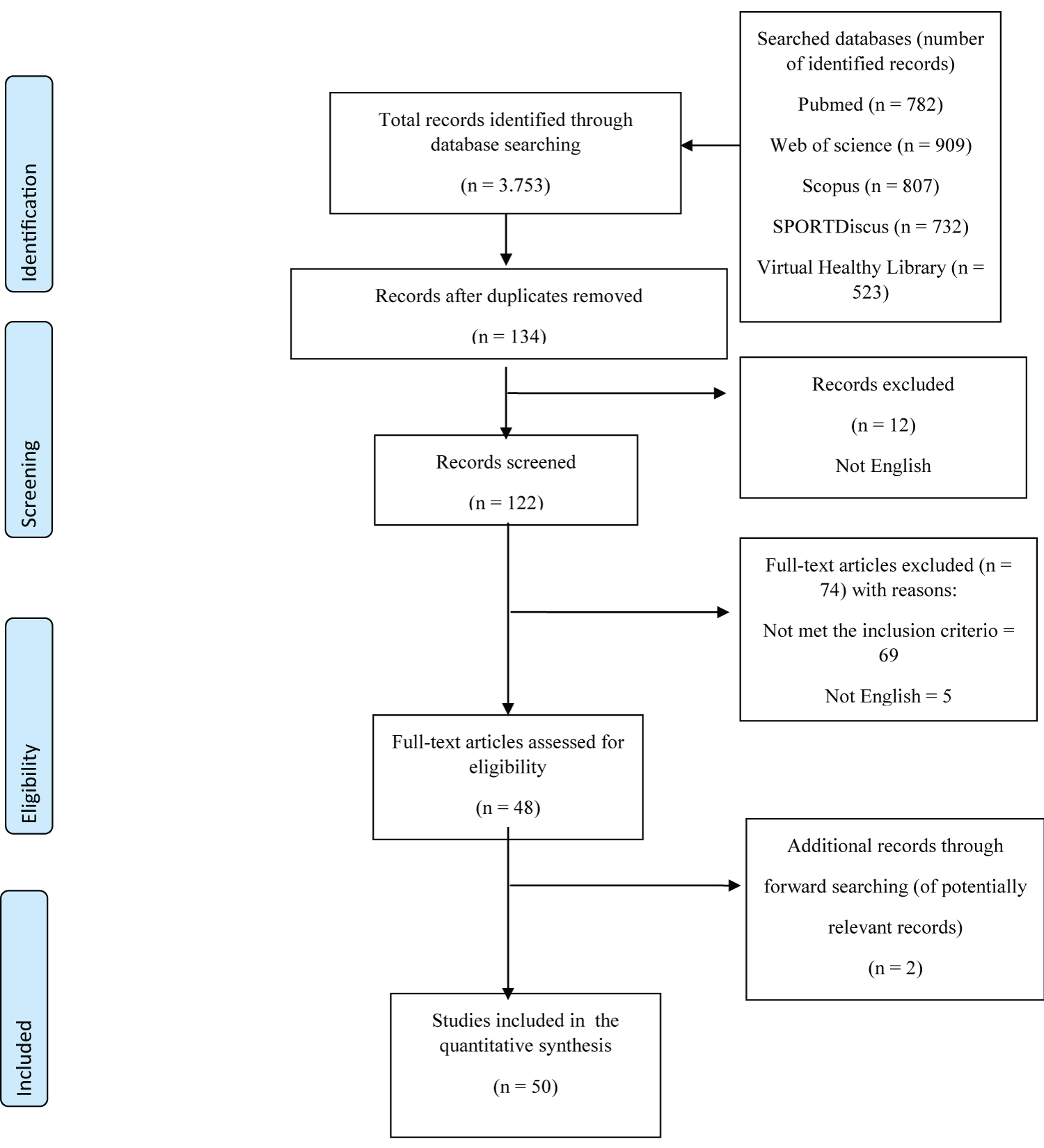 Figure 1: Flow chart.
View Figure 1
Figure 1: Flow chart.
View Figure 1
The temporal distribution of publications, the cumulative number of publications, and the percentage of publications per year are shown in Figure 2. The articles were published between 1992 and 2021 [2,21-69]. Throughout the 1990s, only one article was published, and in the following decade, two more articles were published [63,64]. In the last decade, there has been a significant increase in publications [2,21,23,24,26,27,30-32,35-39,41,42,44-62,66-69], representing almost 80% of the number of publications throughout the period. The years 2018 and 2019 were the two years with the highest number of publications, representing more than 50% of the articles published.
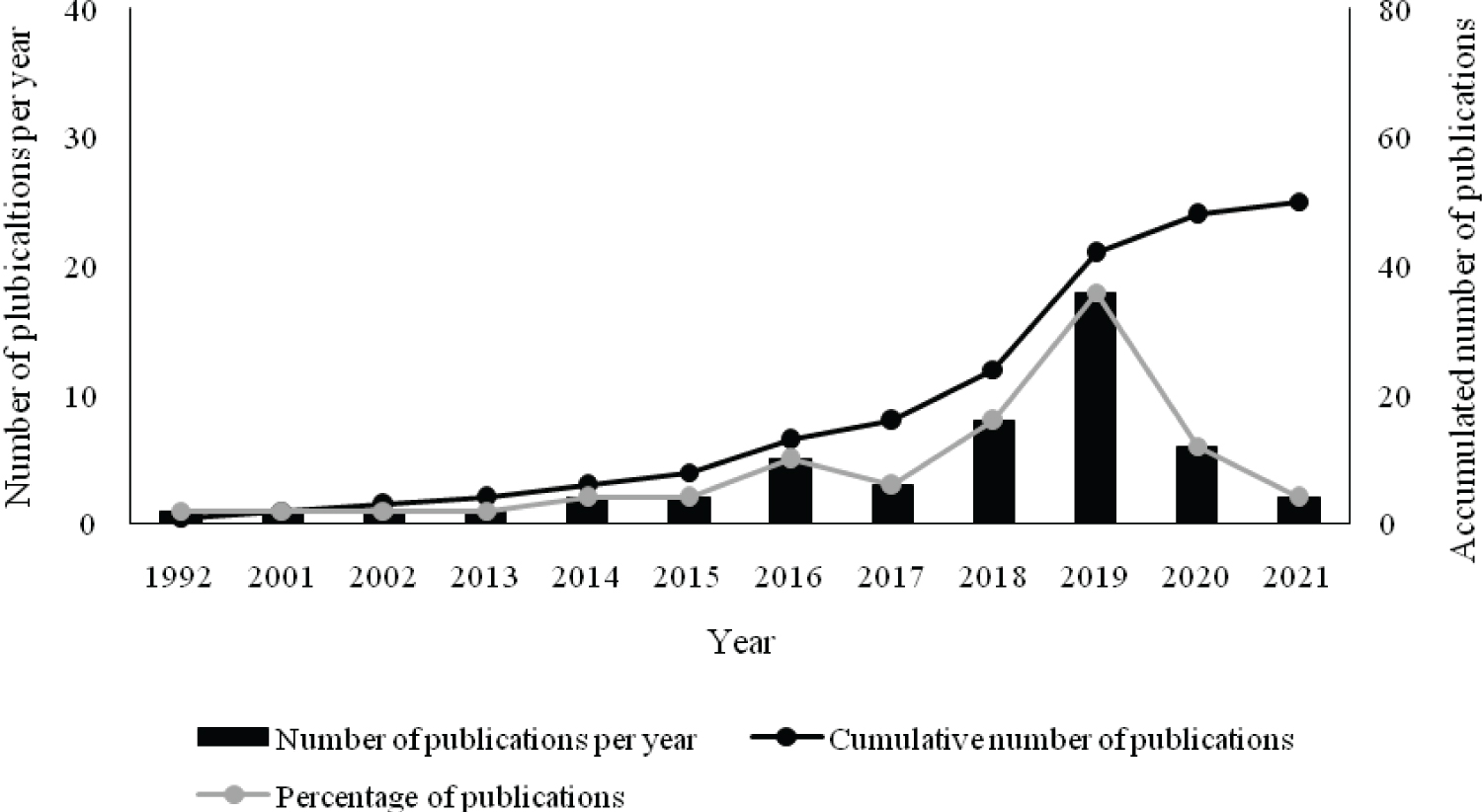 Figure 2: Temporal distribution of articles on athlete's sleep (1992-2021).
View Figure 2
Figure 2: Temporal distribution of articles on athlete's sleep (1992-2021).
View Figure 2
Table 1 of the supplementary material presents the 50 studies with the information: First author, year of publication, place of data collection, sample, performance level, and the instrument used to monitor sleep. There was a great continental disparity, with Oceania [2,24,25,30,32,35-39,47,49-62,67], responsible for more than 50% of the articles. Brazil [22,23,28,29,46], Japan [33,45,69] and Portugal [41-43,48] were the countries with more publications in America, Asia, and Europe, respectively. There was no publication from the African continent.
The minimum sample quantity was seven athletes [30,52] and the maximum was 817 athletes [45]. A total of 2964 athletes was observed, with 1068 female athletes. The sample was composed only of women in 14% of the articles [2,41,42,48,51,55,66], while in 60% of the articles the sample was composed exclusively of men [22,24-28,30-32,34-40,43,47,50,54,56-61,63-65,67]. In 40% of the articles the sample was composed only of athletes with international performance [2,23,26-30,32,33,38,40,45,46,49,59,63,65,66,68,69] and in 4% of the articles the sample was composed with of athletes with national and international performance [39,52,61,62]. Fifty-six sports modalities were present in the articles. The team sport and individual sport most observed were soccer [22,27,28,30-32,41,42,45,48,49,57,62,63,66,67,69] and swimming [23,29,45,46,52,53,69], respectively.
Regarding the type of study (Figure 3), 30% of the articles were experimental [28,29,33,34,36,38,44,46,57,59,61,63,65-67]. With regard to study time, 42% of the articles were longitudinal [22,25,26,30,32,34,35,38-44,52-55,57,60,61], with a minimum period of two weeks [52-54] and a maximum of two seasons [32]. In only 12% of the studies the design of the articles was longitudinal and experimental [38,44,57,61], with the total research period between two to nine weeks, and in 32% the design was longitudinal and descriptive [22,26,30,32,35,39-42,52-55,60], with a minimum and maximum period of two weeks [52-54] to two seasons [32], respectively. In 18% of the articles the design was cross-sectional and experimental [28,33,36,46,59,63,65-67], and in 38% of the articles the design was cross-sectional and descriptive [2,21,23,24,27,31,37,45,47-51,56,58,62,64,68,69].
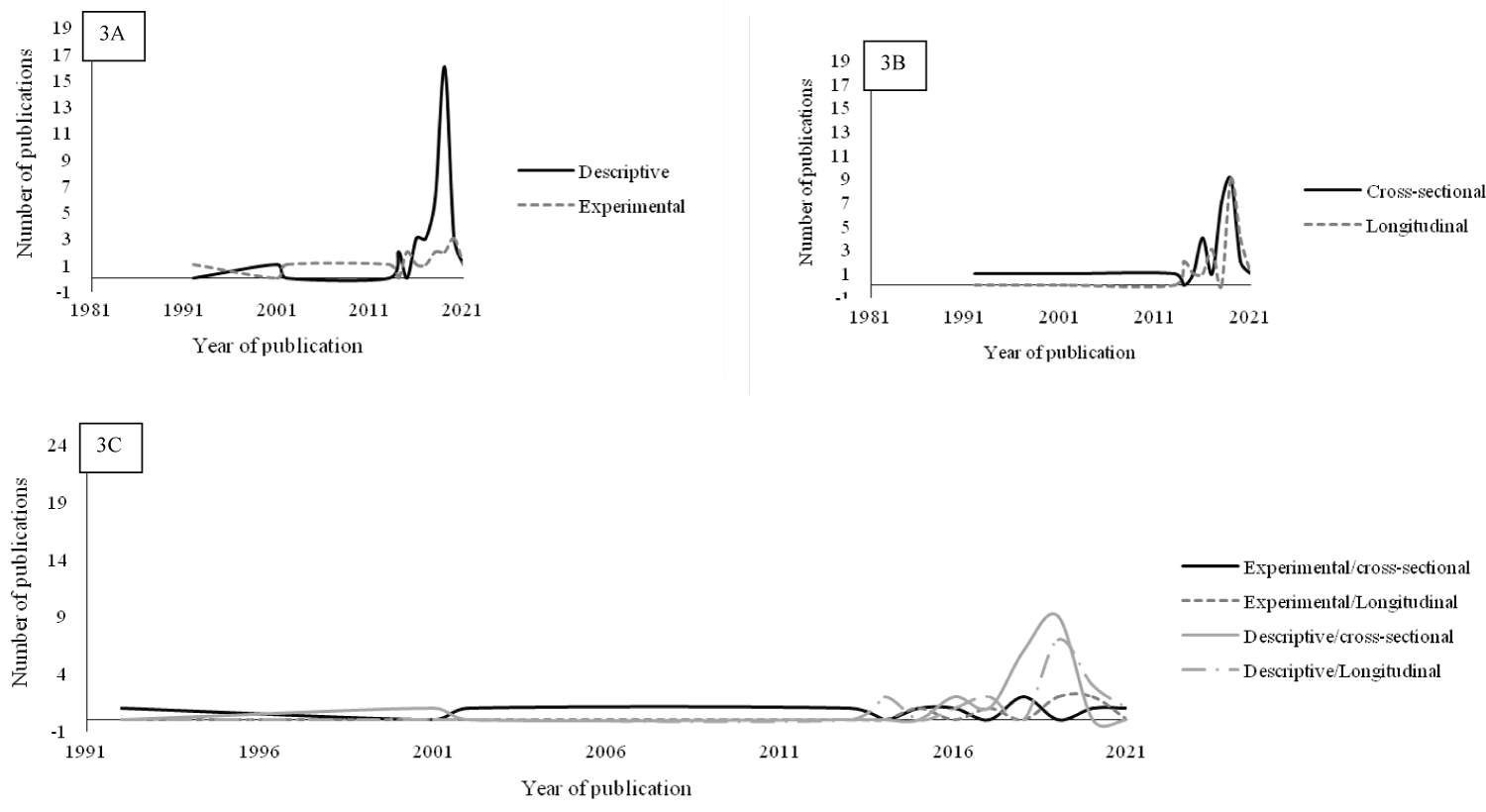 Figure 3: Temporal distribution of the articles regarding the type of study (3A), study time (3B), and study type and study time combined (3C).
View Figure 3
Figure 3: Temporal distribution of the articles regarding the type of study (3A), study time (3B), and study type and study time combined (3C).
View Figure 3
Figure 4 shows the temporal distribution of the instruments used to monitor sleep. Actigraphs, sleep diaries and questionnaires were the most used instruments. It is noteworthy that the first study with polysomnography was in 2001 [64] and the first study with actigraphy was in 2014 [52]. The different instruments were used together in several studies, such as: Actigraphy and sleep diary [2,21,27,30,36,38,44,46,51-54,57,60,61,67], actigraphy and questionnaires [2,38,39,44,50,57,60], and questionnaires and polysomnography [47,50]. From 2015 onwards most studies used actigraphy to describe sleep. Philips Respironics actigraphs were the most used (Figure 5). The most used models were Actiwatch 2 [21,22,29,44,46,57,60]. Actical [2,24,50,51], and the Aw-64 [53,54], however, some articles did not describe the model used [30,52,61,67]. The second and third most used actigraphy brands were ActiGraph [27,41,42,55,60] and Fatigue Science [26,36-39], respectively. Actigraphy was used for at least one day [50] and a maximum of 30 weeks [55]. Compumedics®Polysomnography was the most used [47,50], while polysomnography's from Embla Systems Inc. [23], and Oxford Medical Systems [64] also were present. In all articles that used polysomnography to describe sleep, the athletes were monitored for one night.
 Figure 4: Temporal distribution of instruments used in articles on adult elite athlete sleep (1992-2021).
View Figure 4
Figure 4: Temporal distribution of instruments used in articles on adult elite athlete sleep (1992-2021).
View Figure 4
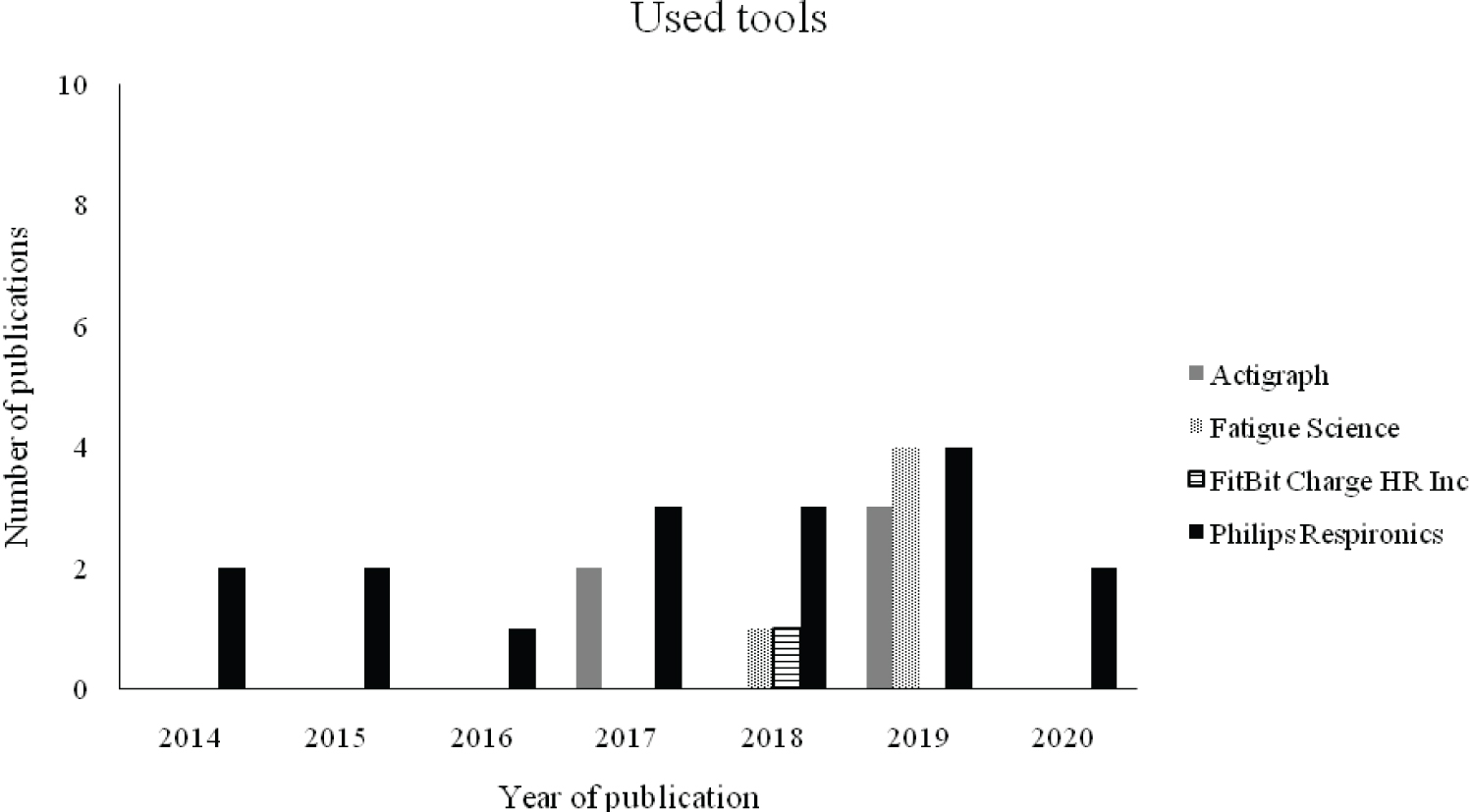 Figure 5: Temporal description of actigraphs used from 2014 to 2021.
View Figure 5
Figure 5: Temporal description of actigraphs used from 2014 to 2021.
View Figure 5
Eleven subjective instruments were utilized since 1994 (Figure 6). The sleep diary [2,21,27,30,35,36,38,44,46,51-54,57,59-61,63,67] was the most used instrument, followed by the Pittsburgh Sleep Quality Index - PSQI- [31,35,38,44,45,49,50,57,68]. The Epworth sleepiness scale [2,31,38,45,47,49,51,57,62], the subjective wellness [25,28,32,34,43,48,60,67], the self-report [40,62,65], the interview [45,69], the Karolinska Sleep Questionnaire [2], the Insomnia Severity Index -ISI- [47], the Liverpool Jet-Lag Questionnaire -LJLQ- [66], and the Visual Analog Scale -AS- [2] were also used. It is noteworthy that there is only one questionnaire specific for the athlete population, the Athlete Sleep Behavior Questionnaire (ASBQ) [38,39].
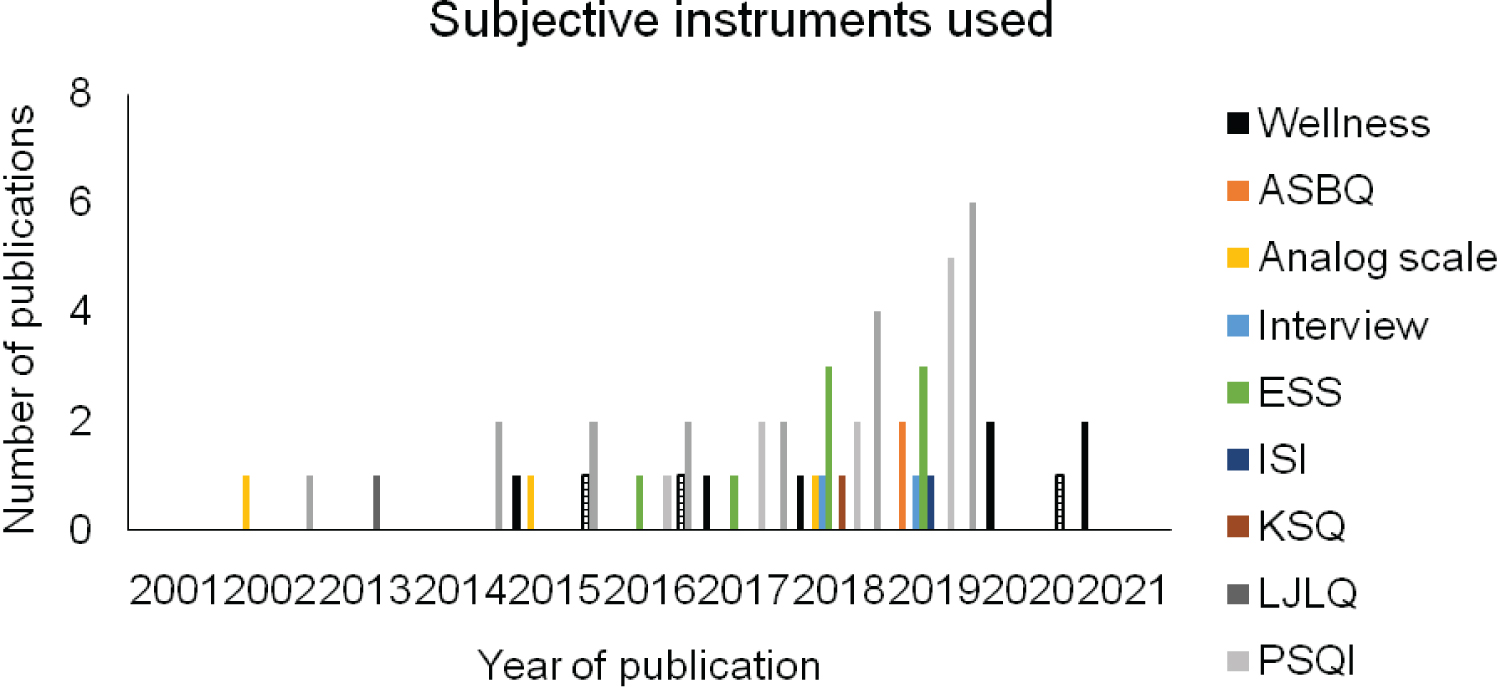 Figure 6: Temporal description of the subjective instruments used from 1992 to 2021.
Figure 6: Temporal description of the subjective instruments used from 1992 to 2021.
ASBQ: Athlete Sleep Behavior Questionnaire; ESS: Epworth sleepiness scale; ISI: Insomnia Severity Index, KSD: Karolinska Sleep Questionnaire; LJLQ: Liveerpool Jet-Lag Questionnaire; PSQI: Pittsburgh Sleep Quality Index; SSS: Stanford Sleepiness Scale.
View Figure 6
With the observation of the presented data, it can be affirmed that in no other historical moment the observation and monitoring of the elite adult athlete's sleep were so inserted in the scientific area. However, several methodological issues contribute to extensive diversity in information content. These questions are a challenge to systematize the information made available in the studies and expand the debate in the scientific world. It can be highlighted that the years 2018 and 2019, with 52% of the total publications, were important to increase the number of publications on this topic.
The present review indicates a growth of studies around elite adult athlete sleep. In the last five years, there has been an increase in the number of publications. Between 2014 and 2020, 37 of the 50 articles were published. Interestingly, until the year 2010, there were only three publications. Three facts are important to help understand this historical evolution. First, it is the effort of different organizations to expand the knowledge of the importance of sleep in the field of public health. The National Sleep Foundation [4] and the American Academy of Sleep Medicine [70] have published recommendations regarding the number of sleep hours, in addition to reinforcing the importance of sleep for health. The American Heart Association [71] published a statement on the importance of optimal sleep and its relationship to cardiometabolic diseases and urged health organizations to include evidence-based sleep recommendations for optimal health.
The second fact to be considered is the assertion of the importance of the athlete's recovery process to improve sports performance, with emphasis on the reviews by Kenttä and Hassmén [72], and Bishop, Jones [73]. Finally, the third fact is the inclusion of studies affirming the importance of sleep for athletes, both in the physical recovery process and for sports performance. Samuels [7] and Halson [74] were the pioneers to review this theme, with publications that indicated the importance of sleep for optimal physical performance [75,76]. Together, these three facts can help us understand this quantitative increase in the publication of articles about athlete sleep.
The results presented in this review point to an overall increase in the number of publications on athlete sleep. However, there is an inequality in the number of publications regarding the continental origin of the studies. For example, there is a concentration of publications in Oceania and a shortage of publications in America and Asia. This shortage is alarming and should be viewed with concern by researchers in these regions. Different geographic factors can affect the athlete's sleep, such as altitude, temperature, and the number of hours of sunshine [77-80]. And these factors are different on different continents. Since sleep can be affected by the geographic characteristics mentioned above, the generalization of research results for application in athletes from different areas of the world should be considered.
We observed that male athletes were more present in the studies in this review, either in number of studies with only male athletes or in the number of male athletes in general. Sports scientists avoid selecting only women as study volunteers due, in part, to methodological challenges and the complexity of reporting heterogeneous results in within- and between-study comparisons [81]. It is known that the menstrual cycle can affect performance in some activities so much [82] as some sleep variables. Thus, future studies must include more elite adult female athletes in the sample, in addition to describing the menstrual cycle so that you can understand the heterogeneous results according to the observed menstrual phase.
Most studies used elite adult athletes with national performance, with 40% of articles with elite adult athletes at the international level. Rating an athlete's performance level is a difficult task, considering the difficulty in obtaining the information needed to rate them. Initially, it is important to understand the differences between exercisers and athletes [83], understand what an elite athlete is [84], and the degree of electiveness [13]. Studying the sample with elite athletes brings several challenges, such as the difficulty to select a homogeneous sample, low sample number, difficulty in randomization, and use of a control group, in addition to generalization of the results. On the other hand, samples with elite athletes allow studying individuals submitted to considerable stress (physical, emotional, and mental) and high levels of fitness [85]. Thus, the classification used in this article serves as an initial survey so that you can describe the articles with elite athletes and, in the future, compare the sleep of the highest-level elite athlete (e.g., Olympic champion) with elite athletes of other levels.
Regarding the sports present in the studies, soccer was the sport present in the largest number of articles in this review. Some factors can be considered for this result. Soccer is the most popular sport in the world, with approximately 400 million players in more than 208 countries [86]. In this way, the great popularity and financial interest can help to understand why soccer is the most researched sport. Other sports stood out due to the number of publications in which they were studied, such as rugby and Australian football. This can be explained by the fact that six of the seven institutions that research the most about athlete sleep belong to Oceania, where rugby is widespread [87,88], as well as Australian football. On the other hand, some modalities were little observed, such as judo, weightlifting, and Mixed Martial Arts. Consequently, future studies may investigate the athlete's sleep in different modalities.
Most articles had a cross-sectional and descriptive design. Cross-sectional research is commonly used in the scientific area, presenting the advantages of collecting large amounts of data, for example, evaluating the sleep of dozens or hundreds of athletes. It is also a relatively quick study and one that can investigate numerous variables simultaneously. However, this type of study allows you to analyze the data in just one moment [89]. The longitudinal and descriptive design represents 32% of the investigated articles. The longitudinal study allows taking notes and detecting any changes that occur in the characteristics evaluated [90]. This type of design was widely used among the studies present in this review since many of them aimed to monitor the sleep of athletes during a certain period, whether in training or competition. The number of studies with a longitudinal and experimental design is still scarce. Thus, more studies with an experimental design that can verify changes in interventions or treatments that impact the athlete's sleep pattern or architecture are important for advancing research on the athlete's sleep. Interestingly, we can observe that in recent years there has been an increase in the number of publications of longitudinal and experimental articles. These study designs are responsible for a small part of the number of publications, but this increase recent increase in the number of publications can be considered due to the relevance of developing strategies that can improve the quantity and quality of sleep on athletes.
Regarding instruments to monitor sleep in elite adult athletes, actigraphy was the most used method. Actigraphy is a device that monitors movements for long periods, where movement scores are translated according to computerized algorithms. Since studies have reported the validation of actigraphy for use in sleep-wake cycle description studies [91], and from reviews and guidelines established for its use, especially for athletes, there was an increase in the number of publications using this instrument. There were only two studies with actigraphy before the year 2015. Previously, data were primarily collected through questionnaires, diaries, and polysomnography. The study of Sargent, Lastella [92], established guidelines for the interpretation and measurements of sleep by actigraphy in athletes, with the definition of the activity count threshold 80 to define wakefulness with the greater agreement, sensitivity, and specificity compared to other thresholds that may overestimate the duration and quality of this recovery period. In this study, 04 times below/above the established threshold were used to define the beginning/end of sleep. The fact that actigraphy is the most used method may be due to its advantages, such as its low cost compared to polysomnography, the possibility of using it in larger numbers of athletes and time intervals simultaneously, in addition to greater ecological validity. However, actigraphy does not present neurophysiological characteristics of sleep [93]. The company that owns the actigraphy most used in the research was validated in the 2000s [94]. Companies with five citations had their validations in 2000 [95] and 2011 [96]. Another point that reinforces the use of the Philips Respironics model is the fact that it is the only model in which there is evidence about its specific validity for elite athletes [92]. To date, there is still no evidence on the validation of other models and brands of actigraphs for competitors. Due to the athlete's training routine and competitions, numerous specifics for this population are reported [8]. From this perspective, the instruments used in this population must be adapted (accelerometer calibration, software settings, among other adaptations) to the reality of athletes, so that errors are reduced about equipment not calibrated for this purpose.
The other two most used instruments, such as the sleep diary and PSQI, are faster to obtain data, however, they are subjective methods and present a greater possibility of error when compared to instruments such as polysomnography and actigraphy. In the study of Samuels, James [97], it was reported that the PSQI underestimates the quality of sleep in athletes, that is, it decreases the quality of sleep through this tool, in addition to showing low agreement for this population. Therefore, the development and use of specific and validated tools for athletes, the ASBQ, is of fundamental importance. The ASBQ is a questionnaire that analyzes the different behaviors related to sleep hygiene and circadian synchronization in specific situations of the sport context [39].
Another interesting point is that few studies used specific questionnaires for the athlete population. Despite its wide use in studies with athletes, the PSQI is not validated and specific about the population, like the ASBQ. However, in the studies presented, the ASBQ was used in only two studies [38,39]. As this instrument was presented and validated in 2018, we suggest greater use of this instrument in studies of elite athletes. In addition, we also suggest the cross-cultural adaptation of these questionnaires, as they are only available in English, Portuguese, and Turkish [98,99]. An increase in the use of these questionnaires is expected in the coming years, as they were recently developed.
This study has some limitations, such as the use of articles only in English, which leads to non-selection of articles published in other languages; the use of only elite adult athletes disregarded modalities in which the peak of performance occurs before the age of 18, such as gymnastics. The exclusion of paralympic athletes or adapted modalities as eligibility criteria for this article may reduce the extrapolation of information for these athletes. Besides, we analyzed only studies with elite adult athletes. The age of peak performance can be different according to the modality or event [100]. So, some studies can be analyzed the sleep pattern in younger elite athletes, however, this sample was not our sample of analyzes.
Thus, it is concluded that in no other historical moment the sleep of the elite adult athlete was so inserted in the scientific area. There is a historical-scientific movement for the use of actigraphy in the description of the sleep-wake cycle, on the other hand, the use of specific instruments for the athlete population is still limited. Historically, most publications are made up of descriptive studies with elite adult male athletes from soccer and rugby. Thus, elite adult athlete sleep research is an expanding area in sports science, and factors such as elite adult athlete's gender and modality, as well as the publication's instruments and geographic location, will contribute to filling the knowledge gaps in this theme. With this, it is expected an advance in the study about the athlete's sleep for greater dissemination of information based on scientific evidence to encourage the awareness of athletes and the technical committee of the importance of sleep for this population.
The authors report no conflict of interest.
No financial organization was involved in the material discussed in the manuscript.
Not applicable.
ACS, LAF, ASA, JPPR, DAB, AS, and MTM all contributed to the paper. ACS designed the search strategy. ACS, LAF, and ASA performed the study selection and composed the manuscript. All authors critically revised it and approved the final version of the article.